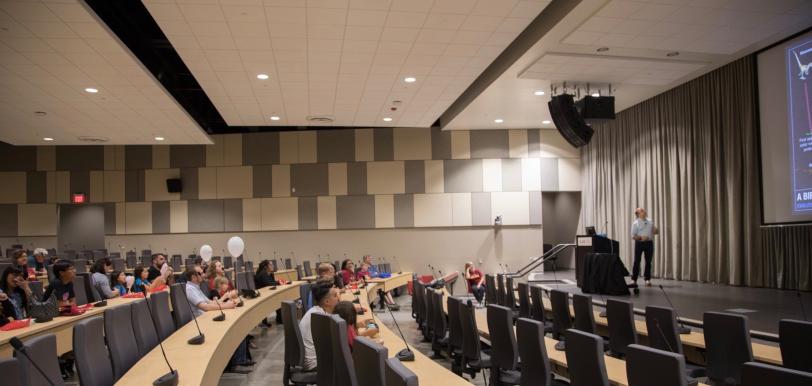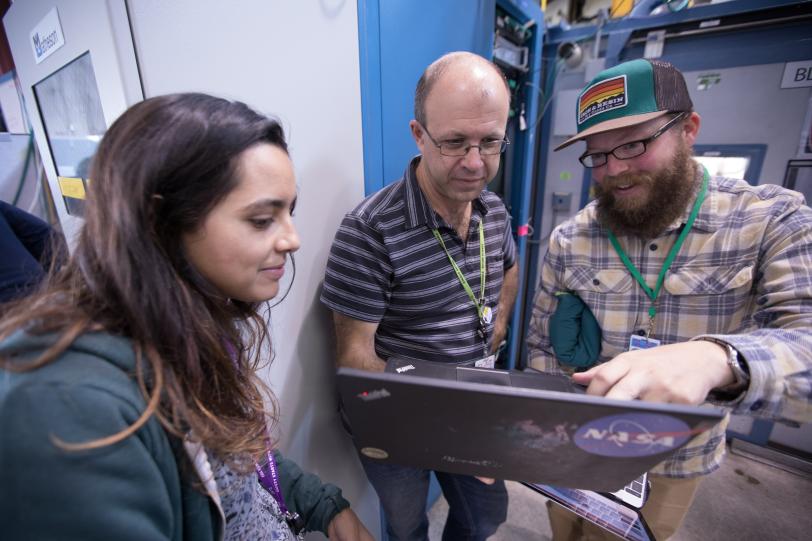Q&A: Sam Webb Teaches X-Ray Science from a Remote Classroom
The staff scientist at the Stanford Synchrotron Radiation Lightsource discusses his research and teaching, which includes training an international group of students to conduct geobiology experiments at the synchrotron from an island about 350 miles away.
By Amanda Solliday
When Sam Webb teaches, he shows that science is a part of everyday life. For him, it’s important that students learn science does not need to be intimidating.
Webb is a staff scientist at the Stanford Synchrotron Radiation Lightsource (SSRL) at the Department of Energy’s SLAC National Acceleratory Laboratory. He started working at SSRL in the fall of 2001 as a postdoctoral researcher.
Over the years, he’s helped with the annual Kids Night at SLAC and other lab outreach events. Webb often visits local classrooms to give science lessons, from demonstrations at his daughter’s preschool to guest lectures at high schools and colleges.
Webb earned his undergraduate and master’s degree at Caltech and a PhD at Northwestern University. His commitment to teaching and strong Caltech connection recently led to a unusual development where graduate students in a geobiology course at the university can watch their X-ray experiments run at SSRL without leaving Southern California.

Q: Why do you think science students should learn X-ray techniques?
It’s one of those tool sets that’s very important for geological, biological and environmental sciences, because you can find a lot of information that you can’t get with other techniques.
You can look at the precise chemistry of samples on really small scales, all the way up to large-scale systems. So X-ray science can be useful to a lot of researchers, and they don’t always get a chance to learn how to actually do it.
Q: How did you become interested in synchrotron research?
During my PhD studies, I was working on an environmental science project that looked at contaminants in the sediments of a lake with a zinc smelter at the edge.
My advisor had never done any research at synchrotrons, but he thought if someone was motivated and wanted to learn about X-rays, it would be a good way to answer some of the questions we had about the different types of metals present in the sediments.
It was really fun to work with a big accelerator at the Advanced Photon Source (APS) at DOE’s Argonne National Laboratory. So when I was done with the project, I thought it’d be great to do some more of the same type of research.
Q: Tell me more about the course you co-taught at Caltech.
It’s a 5-week intensive course where the students do a few weeks of field work and collect different types of samples including rock, sediment and DNA. They also analyze those samples in the lab. The goal of the course is to learn how to look at the relationships between geology and what’s living on Earth.
We’ve taught a variety of techniques, such as taking thin slices of rock samples, extracting DNA and lipids, and doing electron microscopy. This year we thought it would be cool to add synchrotron X-ray methods, because that might not be something a student would be exposed to in a typical geobiology course.
There were about 20 students taking the course this past year. Because it was too difficult to get all the students up to Northern California from the Los Angeles area, we decided to operate the synchrotron remotely from Southern California.
Q: How did that work, exactly?
I went down to Santa Catalina Island, where part of the course takes place at the University of Southern California’s Wrigley Marine Science Center. While I was there, I could run the SSRL beamline from my computer in a lecture hall setting. We had a postdoctoral researcher at SSRL helping us actually put the samples in front of the beam, so we could analyze the students’ samples remotely.
The students did some preliminary work in advance to figure out what they wanted to know, and we would discuss what we might be able to get with the technique. We then looked at the results together as they came out in real time from the beamline. It was a lot like doing three days of actual beam time; we just weren’t at SSRL. Many of the samples came from areas of interest in California – such as Mono Lake and the Monterey Formation. We used the X-rays to study the relationships between microbiology and the rock record, both in terms of current processes and those that may have happened millions of years ago.
Q: When did you start using X-rays for geobiology research?
Woody Fischer – a geobiology professor at Caltech – had called me out of the blue. Someone had suggested that he contact me if he was interested in examining manganese in rocks. Over the phone, we talked about X-ray techniques and what we could do with them, and then I invited him to come up for some of my beam time during the following week. It all worked really well, and we wrote up a proposal for some additional time at SSRL, and we’ve been working together ever since.
We started with the chemistry of manganese in rocks that are 2.5 billion years old. This is around the time that oxygen started building up in Earth’s atmosphere, produced by ancient bacteria that used manganese-containing enzymes for photosynthesis. The manganese records in these rocks helped us hypothesize that there may have been cyanobacteria that could do photosynthesis linked to the manganese cycle before they evolved the ability to evolve oxygen. We’ve also started looking at iron-sulfur cycles within early Earth. And we’re continuing to look at manganese in meteorites, as well as samples from Earth in the form of desert varnish – a dark coating of minerals and elements that can form on rocks found in extremely dry climates. So we’re focusing on geobiology in both modern and ancient systems, here on Earth and in extraterrestrial environments.

Q: What are some of the challenges with investigating these types of samples?
Some of these rocks are more than 2 billion years old, so a lot can happen in that time. It takes quite a bit of careful work to look at the relationships within the rock on a microscale. We want to understand how it might have changed and when, to avoid the pitfalls of making conclusions based on something that happened at a different time in a rock’s history.
Q: Do you often run the beamlines from a remote location?
Not usually, because it’s helpful to be able to see what you’re working on. But this sort of remote access allows us to support and troubleshoot four beamlines with our limited staff of two or three people.
This is the first time we’ve used remote access in a course setting. It was a lot of fun and the students seemed excited to find ways to apply the newly learned technique to their research.
Some of the results are really interesting, and we’ll try to publish those findings. So there’s some real science that will come out of the project, as well.
SSRL and APS are DOE Office of Science user facilities.
For questions or comments, contact the SLAC Office of Communications at communications@slac.stanford.edu.
SLAC is a multi-program laboratory exploring frontier questions in photon science, astrophysics, particle physics and accelerator research. Located in Menlo Park, Calif., SLAC is operated by Stanford University for the U.S. Department of Energy's Office of Science.
SLAC National Accelerator Laboratory is supported by the Office of Science of the U.S. Department of Energy. The Office of Science is the single largest supporter of basic research in the physical sciences in the United States, and is working to address some of the most pressing challenges of our time. For more information, please visit science.energy.gov.




